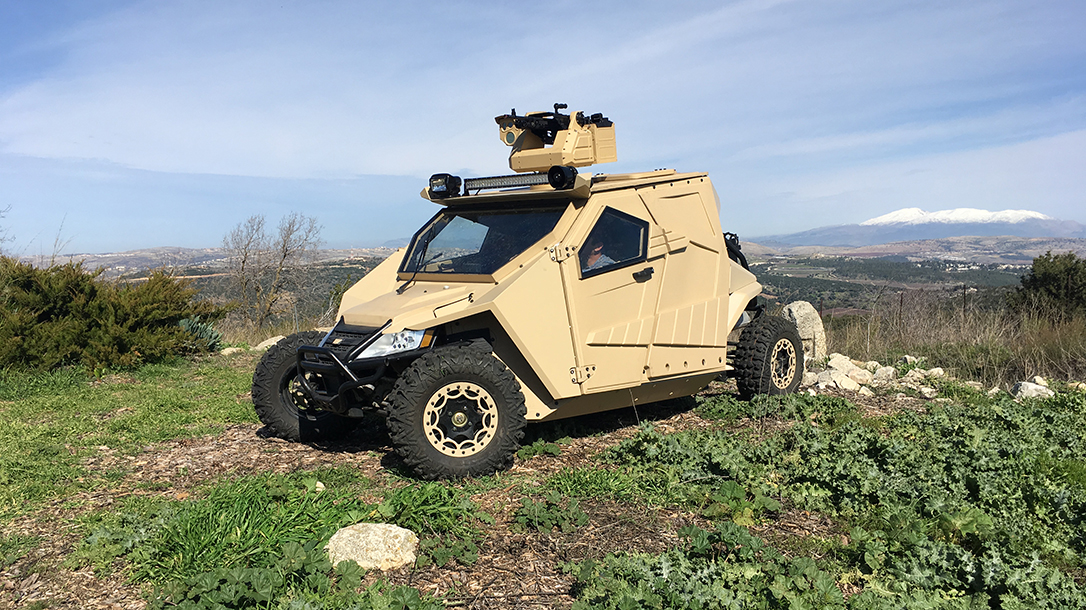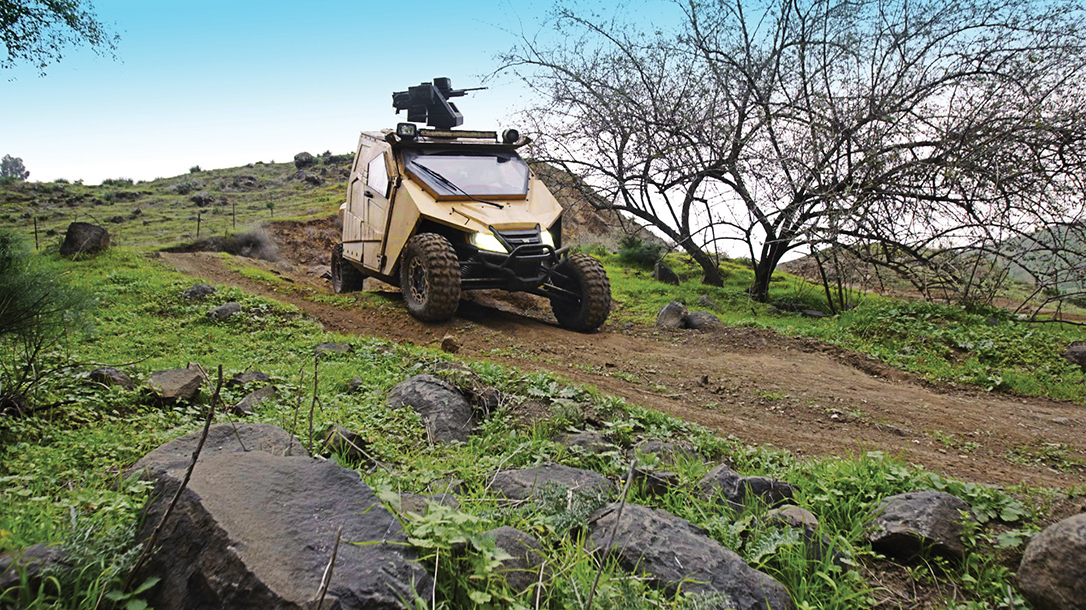The Plasan Yagu lightweight armored vehicle injects a previously unimagined capability into the special operations battlespace. Combining high mobility, air transportability and formidable firepower, the Yagu can transport special operators to their area of operations. Further, it can then protect them while maneuvering downrange. Offering amazing capabilities at a modest weight and relatively reasonable price, the Yagu could revolutionize the way modern spec-ops warriors travel. Today’s cutting-edge Yagu harkens from a fascinating evolutionary family.
In The Beginning
In the early 1930s, the U.S. Army began experimenting with the concept of a bantamweight truck for use by scouts and raiders who were the early 20th century predecessors to today’s special operations forces. The resulting vehicle stemmed from a laborious developmental process. It then became a ubiquitous part of Allied forces in all combat theaters during World War II. The refined design was christened the “U.S. Army Truck, ¼ ton, 4×4, Command Reconnaissance” vehicle. Subsequent generations just called it the Jeep. General George C. Marshall referred to the boxy little vehicle as “America’s greatest contribution to modern warfare.”
Advertisement — Continue Reading Below
Everyone who served during that era has some affectionate tale that stems from his or her relationship to a Jeep. The vehicle weighed 1,975 pounds empty and was endlessly versatile. Ford and Willys Overland produced more than half a million of these remarkable vehicles by war’s end. After WWII, the civilianized Jeep became the world’s first commercially produced four-wheel-drive vehicle.
Subsequent improved versions of the Jeep were ultimately replaced with the larger, more powerful and more stable Humvee in 1984. While the Humvee is an effective utility vehicle, it is too large to ride as internal cargo in most aircraft. As such, it was not designed from the outset to incorporate armor protection. This deep into the 21st century, we can do better.
Meet The Yagu
The special operations equipment procurement system is much more agile than that which supported the Big Army over the past century. Nowadays, promising new commercial off-the-shelf civilian technologies can be folded into military applications without enduring the time-consuming and cumbersome procurement and evaluation processes of previous eras. As a result, civilian-inspired vehicles like the Plasan Yagu can see action soon after they become available.
Advertisement — Continue Reading Below
At its heart, the Yagu is actually a 1,687-pound Arctic Cat four-seat all-terrain vehicle upgraded with armor protection and military-grade accoutrements. The resulting vehicle offers unprecedented capabilities. Also, with an onboard power generation system, a highly survivable armored and air-conditioned crew capsule, and an ultra-light General Robotics Pitbull remotely operated weapon system, the Yagu is agile, rugged and lethal.
The armored crew capsule offers B6+ ballistic protection that is proof against 5.45x39mm, 7.62x39mm, and 7.62mm NATO threats. This radical armor plating is of the composite sort incorporating aramid and Kevlar layers that offer superlative protection at modest weight. Also, the remotely operated Pitbull turret can accommodate 5.56mm or 7.62mm machine guns. This turret also incorporates electronic sensor systems for surveillance and targeting duties under conditions of limited visibility or battlefield obscurants. Generous front and side windows offer exceptional visibility while ancillary external cameras cover dead spots.
Plasan Yagu Power
The Yagu draws its power from a 951cc 1000 H2 V-Twin SOHC engine with electronic fuel injection. Even fully loaded, this gives the Yagu a power-to-weight ratio of 53 horsepower per ton. When combined with an automatic transmission that offers high and low gear ranges, two- or four-wheel drive, and long-travel front and rear suspension, the Yagu becomes remarkably maneuverable. Additionally, the vehicle’s thin footprint makes it ideal for navigating tight urban spaces that might be littered with the detritus of war.
Advertisement — Continue Reading Below
It would be easy to say that the Yagu is the sort of vehicle RoboCop might drive. But RoboCop never dreamt of anything this capable. In addition to a rugged drivetrain and powerful engine, the Yagu also includes a built-in drone system that can be launched from under armor and offer up to 27 minutes of remote video, surveillance and targeting information to increase the crew’s reach beyond the immediate area. Automatic target-tracking software decreases the crew’s workload and enhances situational awareness.
In addition to these unprecedented capabilities, the Yagu will fit inside the cabin of modern combat rotorcraft like the CH-47. Back in the Stone Age when I flew Chinooks, one of our perennial challenges was transporting Humvees. Whereas preceding Jeeps fit snugly inside the cabin, Humvees require transportation externally via sling loads. In addition to taking a toll on the aircraft’s speed and maneuverability, this method of transport also demanded an extra layer of complexity during operations in the pickup and landing zones. By contrast, the Yagu can drive on and off the aircraft in moments.
Practical Applications
The military applications for the Yagu are limited solely by the commander’s imagination. Deep-penetration missions for surveillance or direct action in rugged terrain can now be facilitated over previously unimaginable distances. By combining air insertion with the vehicle’s innate speed and rough-country capabilities, special operations teams can cover vastly greater distances than might be the case were they on foot. Additionally, the vehicle’s prodigious payload carries more food, water and ammunition in its loadout. Quiet and capable, the Yagu can serve as a highly mobile miniature patrol base for small spec-ops units operating deep downrange.
Advertisement — Continue Reading Below
In addition to its military applications, the Yagu offers new capabilities to law enforcement and security services as well. From patrolling vast areas of austere borderlands to monitoring volatile combat zones and peacekeeping operations, the Yagu offers markedly greater mobility, transportability and crew protection capabilities when compared to legacy vehicles. The Yagu serves as a very real force multiplier for both strategic and tactical commanders, particularly in the fluid environment of a digital age.
Street Cred
Plasan has extensive experience designing and building full-sized tactical vehicles. Its influence on the MRAP, M-ATV and JLTV, as well as its Sandcat armored utility and personnel carriers, uniquely position the company to develop a small, lightweight and survivable combat vehicle for tomorrow’s battlefields. The influence of these proven vehicles is manifestly obvious in the design of the Yagu.
In addition to all this combat cred, Plasan has also produced carbon-fiber components for the Dodge Viper ACR, Chevrolet Corvette C7 Stingray and Ford GT500KR sports cars. This influence gives the Yagu a seriously sinister look that really does transport one viscerally into the realm of science fiction.
Advertisement — Continue Reading Below
Cheaper than traditional large-footprint armored vehicles and offering greater agility, better stealth and lower operating costs, the Yagu and its crew of three operators stand ready to revolutionize modern warfare. In an era of advanced technology on the battlefield, Plasan miniaturizes armored transport into something manageable, capable and lethal. The Plasan Yagu is the shape of tomorrow’s combat.
For more information, visit plasan.com.


























